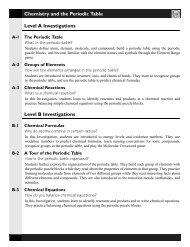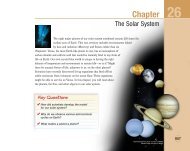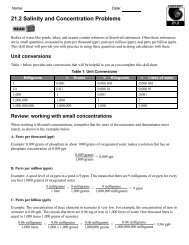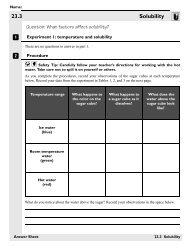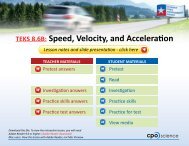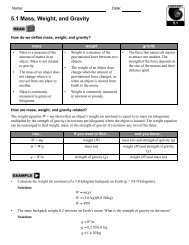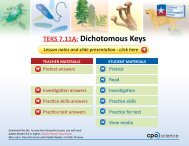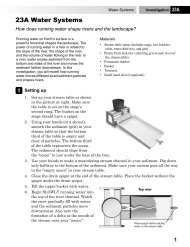16.1 Classifying Matter
16.1 Classifying Matter
16.1 Classifying Matter
- No tags were found...
You also want an ePaper? Increase the reach of your titles
YUMPU automatically turns print PDFs into web optimized ePapers that Google loves.
Chapter 16<strong>16.1</strong> <strong>Classifying</strong> <strong>Matter</strong>What is matter? <strong>Matter</strong> is easier to describe than to define. Your book, your desk, your lunch, the airthat you breathe and the water you drink are all made of matter. <strong>Matter</strong> is a term used to describeanything that has mass and takes up space. Different kinds of matter have different characteristics, suchas boiling and melting temperatures, hardness, and elasticity. In this section, you will learn how matteris classified. By the end of the section, you should be able to define mixture, homogeneous mixture,heterogeneous mixture, substance, element, and compound.How do scientists classify matter?Mixtures containmore than onekind of matterHomogeneousmixture isthe samethroughoutTwo samples of aheterogeneousmixture could bedifferent<strong>Matter</strong> can be divided into two categories: mixtures and substances. Mixturescontain more than one kind of matter. For example, cola is a mixture that can beseparated into carbonated water, corn syrup, caramel color, phosphoric acid,natural flavors, and caffeine.A homogeneous mixture is the same throughout. In other words, all samples of ahomogeneous mixture are the same. For example, an unopened can of cola is ahomogeneous mixture. The cola in the top of the unopened bottle is the same asthe cola at the bottom. Once you open the can, however, carbon dioxide willescape from the cola making the first sip a little different from your last sip. Brassis another example of a homogeneous mixture. It is made of 70 percent copper and30 percent zinc. If you cut a brass candlestick into ten pieces, each piece wouldcontain the same percentage of copper and zinc.A heterogeneous mixture is one in which different samples are not necessarilymade up of exactly the same proportions of matter. One common heterogeneousmixture is chicken noodle soup: One spoonful might contain broth, noodles, andchicken, while another contains only broth.Figure <strong>16.1</strong>: Carbonated softdrinks are homogeneous mixtures.Figure 16.2: Chicken noodle soupis a heterogeneous mixture.<strong>16.1</strong> <strong>Classifying</strong> <strong>Matter</strong>269
Chapter 16How can youseparate mixturesinto substances?Separating mixtures into substances is a very important part of scientific work.Medical researchers try to isolate the substances in plants that may help healdiseases. Forensic scientists try to match evidence from the scene of a crime withsubstances found with a suspect. Nutritionists evaluate the amount ofcarbohydrates, fats, proteins, vitamins, and minerals in various foods.Separating mixtures is not always an easy task. In this unit you will learn about avariety of physical properties that can be used to identify substances in a mixture.Later, you will learn how chemists work to break down substances even further, sothat they can separate compounds into elements.Petroleum is aheterogeneous mixtureTable <strong>16.1</strong>: Summary of the types of matterType of matter Definition ExamplesHomogeneous mixtureHeterogeneous mixtureElementCompoundA mixture that containsmore than one type ofmatter and is the samethroughout.A mixture that containsmore than one type ofmatter and is not the samethroughout.A substance that containsonly one type of atom.A substance that containsmore than one type ofatom.soda pop, air,chocolate ice creamchicken soup, soil,fudge ripple ice creamcopper metal, oxygen gas,liquid nitrogentable salt, rust (iron oxide),carbon dioxide gasPetroleum is a very old andcomplex mixture that weextract from the Earth.Formed millions of yearsago, petroleum contains100,000 to 1,000,000different molecules! A usehas been found for just aboutevery component of thisheterogeneous mixture.Important petroleumproducts include fuel, oils,asphalt, and waxes. Refiningpetroleum is a process that isused to separate the specificcomponents to make eachproduct. Refining includesphysical processes (likedistillation) and chemicalreactions to isolate thecomponents of petroleum.<strong>16.1</strong> <strong>Classifying</strong> <strong>Matter</strong>271



